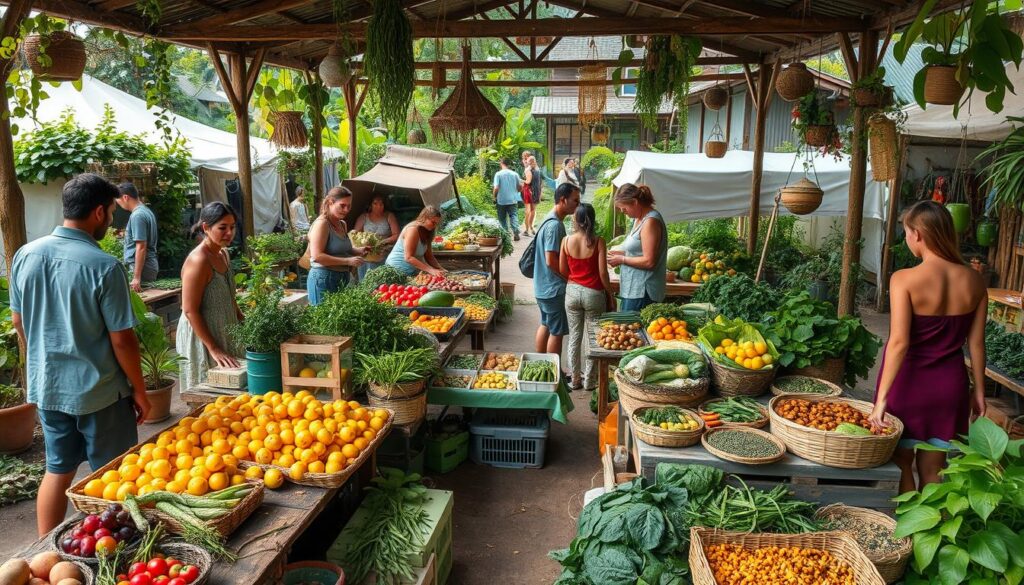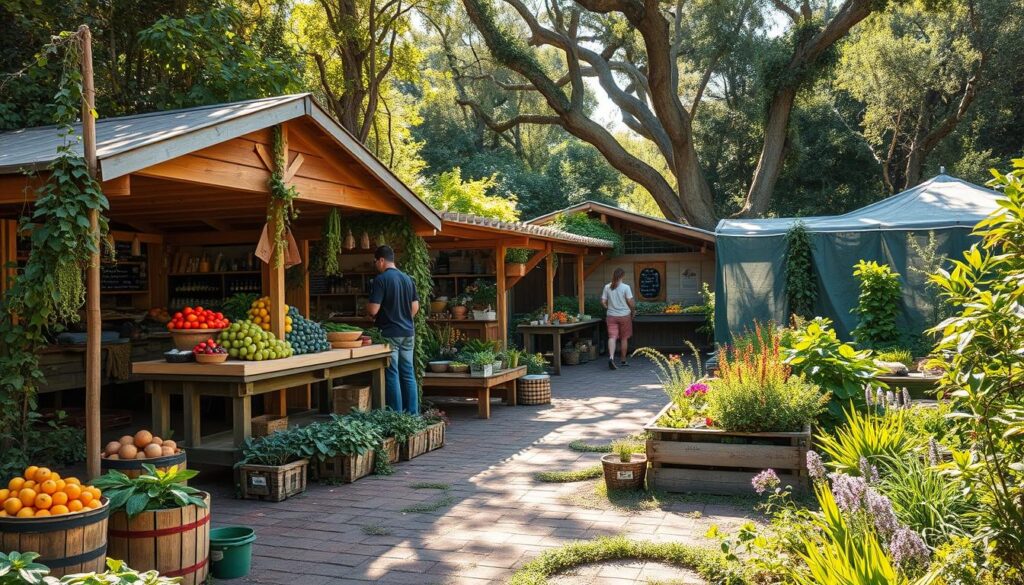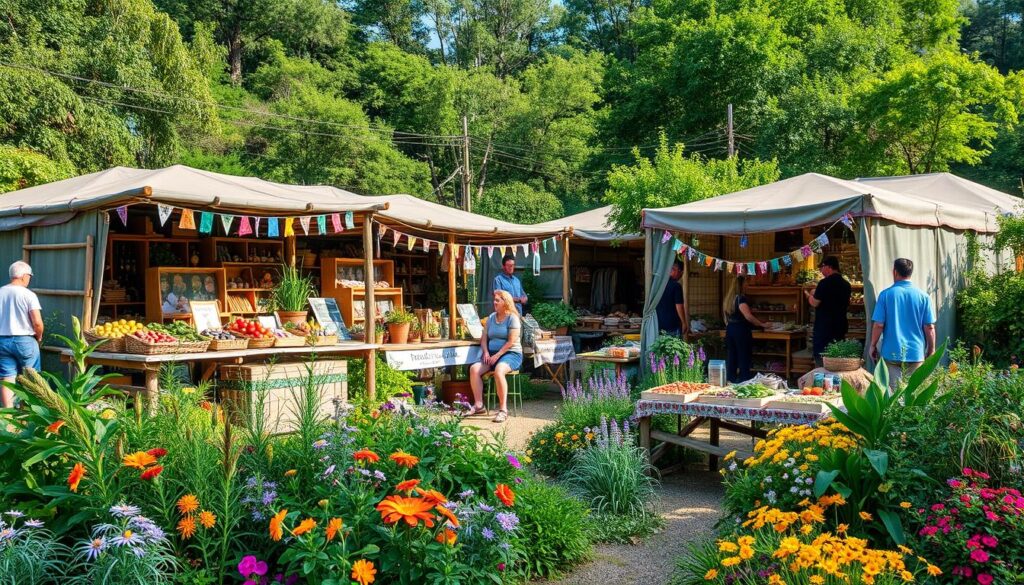A surprising statistic shows the U.S. monetary base grew from $856 billion to $1.749 trillion between April 2008 and April 2009. This is a 104% increase without new wealth or production. This growth highlights the need for new trading systems that focus on permaculture and sustainable finance.
Alternative trading systems are key for a community-driven finance approach. They value tangible goods and services, supporting permaculture and sustainable finance.
Regenerative investing and permaculture trading systems discourage hoarding. They encourage the recirculation of resources, leading to a more sustainable economy. By using alternative trading systems, communities can grow locally and reduce their reliance on traditional finance.
Introduction to Alternative Trading Systems
Systems like local employment trading and community barter clubs keep money in the community. They reduce economic leakage and boost resilience. These systems focus on cooperation, not competition, aligning with permaculture and regenerative investing.
Key Takeaways
- Alternative trading systems promote sustainable finance and regenerative investing
- Permaculture trading systems focus on community-driven approach to finance
- Regenerative investing encourages recirculation of resources within a community
- Local economic growth is promoted through alternative trading systems
- Community resilience is rooted in cooperation rather than competition
- Permaculture trading systems reduce economic leakage and promote community development
Understanding Permaculture Trading Systems
Permaculture trading systems aim to make local economies more sustainable and balanced. They focus on the community’s and environment’s well-being, not just profit. By using ecological markets and green financial initiatives, these systems offer a more complete view of finance.
These systems bring many benefits. They increase sustainability, boost local economies, and support eco-friendly trading platforms. They also lessen the environmental harm of traditional trading, making the economy more regenerative and strong.
- Community-based decision making
- Local currency systems
- Bartering and exchange programs
- Eco-friendly trading platforms
By embracing permaculture trading systems, communities can build a more sustainable and resilient economy. This economy values the well-being of people and the planet equally.
| Feature | Description |
|---|---|
| Community-based decision making | Decision making is based on community input and participation |
| Local currency systems | Local currencies are used to promote local trade and economic development |
| Bartering and exchange programs | Bartering and exchange programs are used to facilitate trade and exchange |
| Eco-friendly trading platforms | Eco-friendly trading platforms are used to promote sustainable trade practices |
Types of Permaculture Trading Systems
Permaculture trading systems aim to make local economies sustainable and strong. They come in forms like barter systems, gift economies, and local currencies. These systems help communities use resources more fairly by reducing dependence on traditional money.
Here are some examples of permaculture trading systems:
- Barter systems, where people swap goods and services without money
- Gift economies, based on sharing and giving back
- Local currencies, boosting local spending and green economy investments
These systems support ethical investment strategies and help build sustainable communities. They encourage people to work together for a fair, green economy.

How Barter Systems Function in Permaculture
Barter systems are key in permaculture, letting communities trade without money. They’re based on sustainable finance and regenerative investing. Here, value comes from real goods and services.
In bartering, people swap goods or services directly. For example, a farmer might trade veggies for bread with a baker. This way, everyone works together, building a strong community.
Trust is vital for barter systems to work well. When people trust each other, they’re more likely to trade and solve problems together. This trust grows from many interactions and mutual benefits.
Many communities worldwide have seen the success of bartering. In New Zealand, the H.A.N.D.S. system shows how trade without money can strengthen communities. The SwapAnHour app also proves the value of time in trade.
| Barter System | Location | Description |
|---|---|---|
| H.A.N.D.S. | New Zealand | A non-currency trade system that fosters community resilience and cooperation |
| SwapAnHour | Global | An app that allows users to exchange one hour of service for another hour |
The Role of Time Banking in Permaculture
Time banking has been around for over 100 years. It’s a way to trade time and skills instead of money. This method has been very helpful during tough economic times, like the great depressions in the US.
In permaculture, time banking is an eco-friendly trading platform. It values everyone’s time equally, which builds a strong sense of community. This is key to permaculture. It also helps with green economy investments by supporting local, sustainable practices.
Benefits of Time Banking for Communities
Time banking boosts community engagement, with up to 90% of people feeling more connected. It also gives people access to more services, with a 30% increase in services received. Plus, it can grow local economies by up to 15% through informal service exchanges.

How to Start a Time Bank
To start a time bank, you need to build a community and set up a system for tracking exchanges. Timebanks USA, with over 120 hubs in the US and other countries, can help. By following these steps and getting support from existing networks, you can create your own time bank.
| Time Banking Benefits | Percentage of Participants |
|---|---|
| Increased community engagement | 90% |
| Access to a wider range of services | 30% increase |
| Enhanced local economies | 15% increase in local trade |
Local Currencies: A Tool for Resilience
Local currencies are key in permaculture trading systems. They help with sustainable finance and regenerative investing. By using local currencies, communities can be less dependent on national money. This makes their economy stronger.
The idea of local currencies isn’t new. Places like the UK have the Totnes Pound and the Lewes Pound. These currencies help communities by encouraging spending locally and supporting local businesses.
What Are Local Currencies?
Local currencies work alongside national money. They help grow local economies. You can use them to buy things from local shops.
Successful Local Currency Examples
The Totnes Pound and the Lewes Pound are good examples. They’ve helped local economies grow. They’ve also made communities stronger.
Advantages for Permaculture Communities
Local currencies offer many benefits for permaculture communities. They help with sustainable finance and regenerative investing. This makes communities more self-sufficient and resilient.
Some key benefits include:
- Promoting local economic development
- Encouraging local spending
- Supporting local businesses
- Fostering community resilience
Establishing a Community Marketplace
To make a community marketplace thrive, focus on ecological markets and green financial initiatives. This helps build a community and supports eco-friendly trading platforms. It lets people trade goods and services, helping local economies and the environment.
Start a community marketplace by creating a place for trading. Use permaculture entrepreneurship to encourage local investment and community involvement.
Essential Features of a Marketplace
Key features of a community marketplace include:
- A platform for buying and selling goods and services
- A system for exchanging goods and services without using traditional currency
- A space for community members to connect and build relationships

Best Practices for Success
To succeed, focus on eco-friendly trading platforms and green financial initiatives. Promote sustainable practices, reduce waste, and encourage community involvement. These steps help a marketplace grow and become a key part of the local economy.
Digital Platforms for Trading in Permaculture
Permaculture communities are growing fast. They need good trading systems that are both efficient and sustainable. Digital platforms offer holistic trading solutions that meet these needs. They let permaculture folks invest in the green economy and follow ethical investment strategies that match their values.
Some key benefits of using digital platforms for trading in permaculture include:
- Increased accessibility and convenience
- Improved transparency and accountability
- Enhanced security and reduced risk
- Greater connectivity and community engagement
Digital platforms also help create local currencies and exchange systems. This supports green economy investments and ethical investment strategies in permaculture communities. By using these new solutions, permaculture folks can build a stronger, more sustainable financial system.
The permaculture movement is getting bigger, and digital platforms are playing a key role. They help with holistic trading solutions. By using these technologies, permaculture communities can work towards a more sustainable and fair future. This future is guided by ethical investment strategies and green economy investments.
| Benefits | Description |
|---|---|
| Increased accessibility | Digital platforms can be accessed from anywhere, at any time |
| Improved transparency | Transactions are recorded and tracked, ensuring accountability |
| Enhanced security | Digital platforms use advanced security measures to protect user data |
The Importance of Trust and Relationships
Trust and relationships are key in permaculture trading systems. They help build a strong community and encourage working together. In permaculture trading systems, keeping promises can boost productivity by 40% and make members happier. Good relationships are vital for keeping everyone involved and working together, with 75% of successful projects saying so.
Most trust comes from keeping promises, and breaking them can hurt future teamwork by 60%. To build trust, focus on being open and clear. Also, have rules that encourage facing problems head-on. This can make group trust grow by 30% and relationships last longer by 50%.
Here are some ways to strengthen trust and relationships in permaculture groups:
- Encourage talking face-to-face and being direct
- Build community with social events and shared goals
- Value openness and being accountable in all dealings
- Use conflicts as chances to grow closer as a group
By using these methods, permaculture groups can lay a solid base for regenerative investing and sustainable finance. This leads to stronger, more cooperative systems. As permaculture trading systems grow, remember the value of trust and relationships. They are crucial for a fair and thriving community.
Education and Workshops on Trading Systems
Education is key in trading systems, just like in permaculture practice. Sharing knowledge through workshops and resources is vital. It helps people make smart investment choices, supporting eco-friendly trading platforms and holistic trading solutions.
For example, the Permaculture Design Course teaches the basics of permaculture. The Trade School Dudley lets people trade for knowledge. These show how education can boost green economy investments and sustainable finance.

There are many learning resources out there, from books to online courses and podcasts. The goal is to make learning fun and accessible for everyone. This way, we can help people join holistic trading solutions and build a better financial future.
Education and workshops are crucial for a community-driven finance approach. By sharing knowledge, we support eco-friendly trading platforms and green economy investments. This leads to a more sustainable and strong financial system.
Integrating Trading Systems into Permaculture Design
Permaculture trading systems can be a great fit for permaculture design. They help with sustainable finance and regenerative investing. This way, communities can build a strong and diverse financial system. It helps them to grow and thrive.
Some key strategies for effective integration include:
- Implementing local currencies to foster community resilience and cooperation
- Developing barter systems to facilitate the exchange of goods and services
- Encouraging time banking to promote community engagement and social connection
By using these strategies, permaculture communities can build a strong financial system. For instance, local currencies keep money in the community. This boosts local growth and development. Barter systems and time banking also help build trust and cooperation. They create a sense of community and mutual support.
It’s important to measure the success of permaculture trading systems. This helps them grow and improve. We can track things like how many people are involved, how much is exchanged, and the benefits to the community. This way, communities can make their systems better and more sustainable.
| Indicator | Description |
|---|---|
| Community participation | Number of community members participating in the trading system |
| Volume of goods and services exchanged | Total value of goods and services exchanged within the system |
| Economic benefits | Increased local economic growth and development |
| Social benefits | Improved social connection and community engagement |
Legal Considerations for Trading Systems
Setting up ecological markets needs careful thought about legal matters. Eco-friendly trading platforms must follow local laws to be seen as trustworthy. It’s also key to know the tax rules for bartering, as they affect the financial health of these projects.
In permaculture, trading often uses non-currency exchanges. These are based on real goods and services. This method helps build strong communities, like the H.A.N.D.S. system in New Zealand. But, it’s important to make sure these systems follow the law to avoid problems.
Important things to think about for eco-friendly trading platforms include:
- Registering as a legitimate business entity
- Obtaining necessary licenses and permits
- Complying with tax laws and regulations
- Establishing clear terms and conditions for trading
By considering these legal points, ecological markets and green financial projects can grow. They help promote sustainable and eco-friendly trading.

| Trading System | Legal Considerations |
|---|---|
| Bartering | Tax implications, contract law |
| Local Currencies | Registration, licensing, compliance with financial regulations |
| Eco-friendly Trading Platforms | Compliance with environmental laws, data protection regulations |
Challenges in Implementing Trading Systems
Setting up trading systems in permaculture communities faces many hurdles. A big issue is the lack of education and financial know-how among members. This makes it hard to create holistic trading solutions that meet the community’s needs.
Another problem is the limited access to green economy investments. This makes it tough for communities to build sustainable trading systems. Also, not having ethical investment strategies can lead to practices that go against the community’s values.
To tackle these issues, communities can try a few things:
- Start educational programs on financial literacy and trading systems
- Look for partnerships with groups that offer green economy investments
- Use ethical investment strategies that match the community’s values
By using these approaches, permaculture communities can set up trading systems that are good for everyone. These systems will be sustainable, fair, and kind to the environment. This way, they can help the community and the planet.
| Challenge | Solution |
|---|---|
| Lack of education and financial literacy | Develop educational programs |
| Limited access to green economy investments | Establish partnerships with organizations |
| Lack of ethical investment strategies | Implement ethical investment strategies |
Future Trends in Permaculture Trading Systems
Looking ahead, permaculture trading systems will be key in sustainable finance and regenerative investing. They help create diverse and resilient financial ecosystems. This way, communities can grow and thrive.
Local currencies, like Mattole’s silver coins, boost community cooperation and resilience.
Some trends to watch include:
- Innovations in community trade, such as online platforms and mobile apps
- The role of technology in enhancing trading, including digital currencies and blockchain
- Predictions for the next decade, including increased adoption of permaculture principles and practices
Experts like David Holmgren say climate change, peak oil, and sustainable living will shape permaculture trading systems. The ‘conserver society’ and ‘earth stewardship’ models will grow in importance. Communities will aim to create self-governing towns with lots of food production and renewable energy.
Integrating permaculture trading systems with sustainable finance and regenerative investing is vital. It helps build a resilient and sustainable financial ecosystem. By using permaculture, communities can move away from centralized systems. This leads to more efficient and sustainable local economies.
| Year | Event | Impact on Permaculture Trading Systems |
|---|---|---|
| 2009 | David Holmgren publishes “Future Scenarios” | Highlights the importance of permaculture trading systems in creating a sustainable future |
| 2020 | Survey reveals 50% of urban farmers incorporate permaculture principles | Indicates growing adoption of permaculture practices in urban areas |
| 2023 | Report indicates 45% increase in social cohesion and community participation | Demonstrates the positive impact of permaculture trading systems on community resilience |
Conclusion: The Value of Alternative Trading Systems
The permaculture movement has grown a lot over 45 years. Alternative trading systems (ATS) play a big role in this growth. These eco-friendly trading platforms and holistic trading solutions help create a more sustainable and community-focused commerce.
By investing in green economy investments, permaculture communities become more resilient and self-sufficient. They use local currencies, time banking, and bartering to achieve this.
Permaculture projects are happening all over the world, from South Africa to the Philippines. They show how appealing these alternative trading practices are globally. These projects help solve big problems like malnutrition and unemployment in Africa and change local economies worldwide.
Looking ahead, it’s important to integrate eco-friendly trading platforms and holistic trading solutions into permaculture design. This will help build trust, transparency, and strong community bonds. Permaculture communities can then lead the way in showing the strength of green economy investments and sustainable trade.

